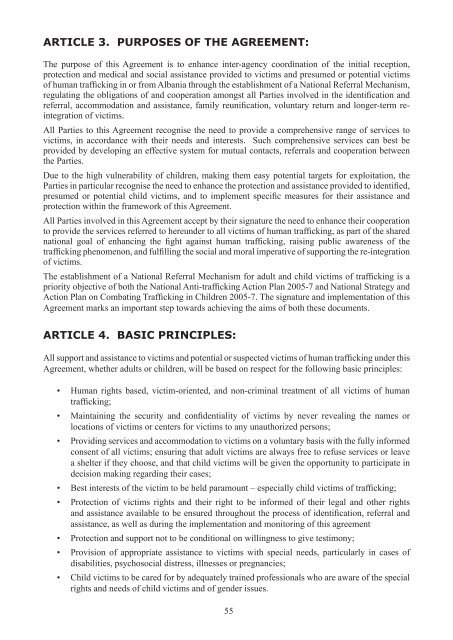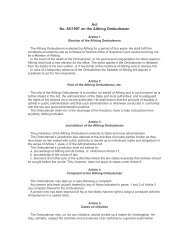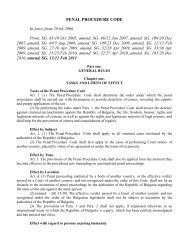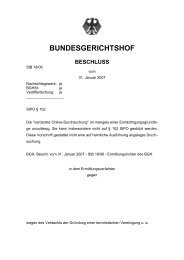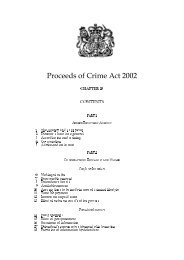strategjia kombetare shqiptare per luften kunder ... - Legislationline
strategjia kombetare shqiptare per luften kunder ... - Legislationline
strategjia kombetare shqiptare per luften kunder ... - Legislationline
You also want an ePaper? Increase the reach of your titles
YUMPU automatically turns print PDFs into web optimized ePapers that Google loves.
ARTICLE 3. PURPOSES OF THE AGREEMENT:<br />
The purpose of this Agreement is to enhance inter-agency coordination of the initial reception,<br />
protection and medical and social assistance provided to victims and presumed or potential victims<br />
of human trafficking in or from Albania through the establishment of a National Referral Mechanism,<br />
regulating the obligations of and coo<strong>per</strong>ation amongst all Parties involved in the identification and<br />
referral, accommodation and assistance, family reunification, voluntary return and longer-term reintegration<br />
of victims.<br />
All Parties to this Agreement recognise the need to provide a comprehensive range of services to<br />
victims, in accordance with their needs and interests. Such comprehensive services can best be<br />
provided by developing an effective system for mutual contacts, referrals and coo<strong>per</strong>ation between<br />
the Parties.<br />
Due to the high vulnerability of children, making them easy potential targets for exploitation, the<br />
Parties in particular recognise the need to enhance the protection and assistance provided to identified,<br />
presumed or potential child victims, and to implement specific measures for their assistance and<br />
protection within the framework of this Agreement.<br />
All Parties involved in this Agreement accept by their signature the need to enhance their coo<strong>per</strong>ation<br />
to provide the services referred to hereunder to all victims of human trafficking, as part of the shared<br />
national goal of enhancing the fight against human trafficking, raising public awareness of the<br />
trafficking phenomenon, and fulfilling the social and moral im<strong>per</strong>ative of supporting the re-integration<br />
of victims.<br />
The establishment of a National Referral Mechanism for adult and child victims of trafficking is a<br />
priority objective of both the National Anti-trafficking Action Plan 2005-7 and National Strategy and<br />
Action Plan on Combating Trafficking in Children 2005-7. The signature and implementation of this<br />
Agreement marks an important step towards achieving the aims of both these documents.<br />
ARTICLE 4. BASIC PRINCIPLES:<br />
All support and assistance to victims and potential or suspected victims of human trafficking under this<br />
Agreement, whether adults or children, will be based on respect for the following basic principles:<br />
• Human rights based, victim-oriented, and non-criminal treatment of all victims of human<br />
trafficking;<br />
• Maintaining the security and confidentiality of victims by never revealing the names or<br />
locations of victims or centers for victims to any unauthorized <strong>per</strong>sons;<br />
• Providing services and accommodation to victims on a voluntary basis with the fully informed<br />
consent of all victims; ensuring that adult victims are always free to refuse services or leave<br />
a shelter if they choose, and that child victims will be given the opportunity to participate in<br />
decision making regarding their cases;<br />
• Best interests of the victim to be held paramount – especially child victims of trafficking;<br />
• Protection of victims rights and their right to be informed of their legal and other rights<br />
and assistance available to be ensured throughout the process of identification, referral and<br />
assistance, as well as during the implementation and monitoring of this agreement<br />
• Protection and support not to be conditional on willingness to give testimony;<br />
• Provision of appropriate assistance to victims with special needs, particularly in cases of<br />
disabilities, psychosocial distress, illnesses or pregnancies;<br />
• Child victims to be cared for by adequately trained professionals who are aware of the special<br />
rights and needs of child victims and of gender issues.<br />
55


